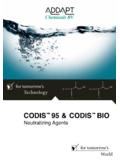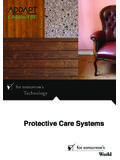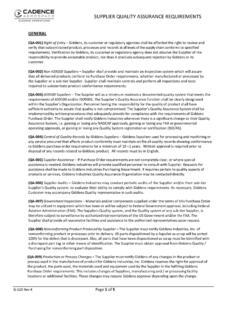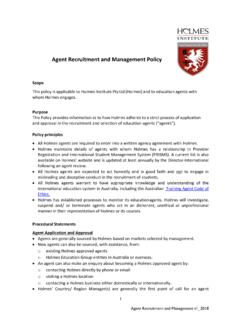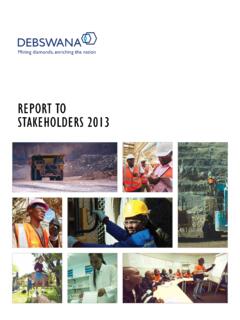Transcription of Foam Control Agents - ADDAPT Chemicals BV
1 Chemicals BV. for tomorrow's Technology foam Control Agents Processing aids for the Food/Feed Industry for tomorrow's World The Foamstop range ADDAPT Chemicals BV offers a comprehensive range of foam Control Agents (FCA) to the food processing industry. Application Foamstop grade Details Sugar production Sugar beet/ SIN 360, SIN 365S, Used in all production steps of sugar Sugar cane SIN 260, SIN 385 manufacturing. Potato processing French fries SIN 360, SIN 365, Used during washing and cutting process SIN 555 of potatoes. The natural surfactants and starch create foaming problems. Chips SIN 360, SIN 555. Starch SIN 365, SIN 366, Used during washing, cleaning and SIN 555 concentrating process. Fruit water SIN 360, SIN 365, Used to Control foam problems during SIN 555 storage and decantation process. Fermentation Alcohol SIN 260, SIN 360, Used during fermentation and distillation SIN 365, FSL 16* process of alcohol.
2 * Used as a process aid and cleaning aid during beer production. Molasses SIN 365, SIN 260, Keeps foam at an acceptable level without SIN 265 interfering with the yield of alcohol. Very effective even at low concentrations. Amino acid SIN 365 Very effective even at low concentrations and facilitates smoother pump operation Citric acid SIN 535, SIN 365 and transport. Lactic acid SIN 535. MSG** SIN 535 ** Mono Sodium Glutamate Yeast SIN 260, SIN 360, F30 Used during fermentation of yeast. Vegetable processing Spinach SIN 555 Very good air release agent which allows smaller packaging. Peas/Leek SIN 388 Used in water bath for cleaning vegetables. Dairy products Dairy SIN 21, SIN 388, Used during whey production/processing FSL 16, FSL 30 and bottling of dairy products. Meat/poultry/seafood/ Meat SIN 385, FSL 16, Used during meat processing.
3 Egg washing FSL 30, FSL 100. Seafood SIN 385, SIN 555, Used during cleaning process; to Control FSL 16, FSL 30, foam resulting from high salt and protein FSL 100 leaching from seafood. Animal feed (non EU) Wet feed/ YCA 40 Used to minimize fermentation of Starch Mixed fodder and Proteins by Biomass, resulting in higher levels of nutrients in the final feed product. Temperatures have a strong influence on the FCA activity. Some Foamstop grades are highly effective at specific temperatures SIN 360 25 C - 90 C. as the overview shows. SIN 366 0 C - 20 C. Notes: ADDAPT Foamstop grades are free of silicones (except SIN 385 5 C - 95 C. FSL-grades). ADDAPT Foamstop grades are Kosher and Halal SIN 388 25 C - 95 C. approved. Certificates are available upon request. FCA's used in the food processing industry are processing SIN 555 10 C - 95 C.
4 Aids and do not remain in the food unless stated otherwise. foam Control Agents Defoaming, Antifoam and Air release The food processing industry battles three different features: Defoaming of the foam bubble Antifoam (prevention of foam bubbles). Air release (removing of gases from the liquid medium). Defoaming foam bubbles can be destroyed with thermal and mechanical methods. However these methods are not practical and can have a major influence on the substrate. Mechanical methods go hand in hand with high installation costs and permanent running costs, which are undesirable. For this reason the chemical method is an attractive and cost effective choice to battle foam . The advantages: Low costs (pumps and pipelines);. Very effective;. Besides defoaming, foam preventing is also possible. Air release foam formation occurs when air or gas is present in the liquid.
5 Therefore, many formulators or end-users use a so-called air release agent '. The air release agent transforms small air bubbles into bigger ones so they can rise to the surface more rapidly. In case the liquid contains surface active components (surfactants), air bubbles that reach the surface are stabilised and foam is created. If the liquid does not contain any surfactants, no foam will be formed and the air bubbles will collapse immediately at the surface, the liquid being completely de-aerated. Air can again be mixed into the liquid by a chemical reaction or by strong agitating process. Typical air release Agents are: solvents (kerosene), silicones and mineral oils with silica. Types of FCA's The industry supplies a wide range of different foam Control Agents . The most widely known classes of FCA's are: Silicones Dimethyl Polysiloxanes (and their polyether modified grades).
6 Mineral oil based grades (modified with silicates). Poly Alkylene Glycols (PAG). Esters (fatty acid initiated or poly alcohol initiated). Solids (powders). Combination of compounds as shown above foam Control Agents for the food industry requires FDA approved grades, for this reason, not every type of FCA can be applied. The sugar, potato, yeast and starch industries use mainly Ester and PAG based FCA's. 3. FDA regulations The Code of Federal Regulations volume 21; parts 170 to 199 lists all Chemicals that are allowed to be used as FCA in food processing (direct or indirect food contact). Normally this list is also the guideline during developmental work in order to ensure the final product is in accordance with FDA regulations (Food and Drug Administration, Department of Health and Human Services, USA). FDA paragraph Class of compound Application PAG, Esters Fruit juice and dry beverage PAG Boiling water additive PAG, Esters, Siloxane Food processing PAG, Ester, Mineral oil, Siloxane Adhesives PAG, Ester, Siloxane Paper and paperboard (food contact).
7 PAG, Ester, Mineral oil, Siloxane, Coatings Silicone PAG, Ester, Siloxane, Mineral oil Paper and paperboard (manufacturing). PAG, Ester Sanitising solutions for food processing equipment Sugar industry Sugar is obtained from two different raw materials: sugar beet and sugar cane. Europe produces mainly sugar beet while South Africa, Brazil, Mauritius, Australia harvest sugar cane. Sugar processing requires different defoamers; the choice depends strongly on the stage of the sugar process. ADDAPT Foamstop SIN 360 and SIN 365S are the most recommended grades for the extraction and evaporation process. ADDAPT Foamstop SIN 365 is recommended to minimize foam formation during the fermentation process of molasses. Sugar beet Processing sugar beet includes washing and transportation of the beets, which (in case of a closed waterway) leads to strong foam formation.
8 These waterways are normally foam controlled by usage of ADDAPT Foamstop SIN 360 and ADDAPT Foamstop SIN 365S. Sugar Cane Sugar canes are not washed nor transported by waterways. foam Control Agents are required in the extraction and clarification processes. ADDAPT . Foamstop SIN 360 and SIN 365S are usually recommended. Recommended Foamstop grades: ADDAPT Foamstop SIN 260, SIN 360, SIN 365S and SIN 385. 4. Potato industry It is estimated that the industry uses over 400 million tons of potatoes every year (world consumption). Besides the consumption of potato as food, potatoes are raw materials for the alcohol and starch production. A study showed that 30% of the potato is consumed as chips and potato, 10% is used as seeds, 50% is sold as cattle feed and only 5% finds its way in distilleries and starch applications.
9 foam Control Agents are used in industrial processes where potatoes are converted into other foodstuffs. The FCA's are needed in the production processes of for example French fries, crisps and chips. Treat levels strongly depend on the cultivation of the potato, soil structure, process temperatures and climatic conditions. The total amount of processed potatoes remained at a constant level for the past 25 years, however the use of FCA's has increased because of improved processing methods with more extensive extraction of components such as starch and protein. Potato structure Potatoes come in different sizes, shapes and colours. Their composition varies strongly depending on their origin, but in general it can be said that an average potato contains the following components: Component Content (%). Water Starch Total sugar Raw protein The foam active ingredients are starch and protein.
10 Pulp The ash contains potassium, phosphate, sodium, calcium, magnesium, iron, chlorine and a residue of Total ash vitamins C, B1 and B2. Fat Potato processing The pre-cleaning of the potatoes usually starts during the unloading process. The main cleaning process happens in washing machines' similar to those used in the sugar industry. The potatoes are immersed in water and stirred thoroughly by iron bars. This cleaning process removes all dirt and peels the potatoes partially. Washing water flows against the potato stream and afterwards the water is pumped into the settling ponds where solids start to separate. The cleaned water is being circulated and some fresh water is added in order to keep the original amount of water. Processing a ton of potatoes requires 2 - 3 m water. The washing water is reused and over time this water contains so much starch and protein it will start to foam .

